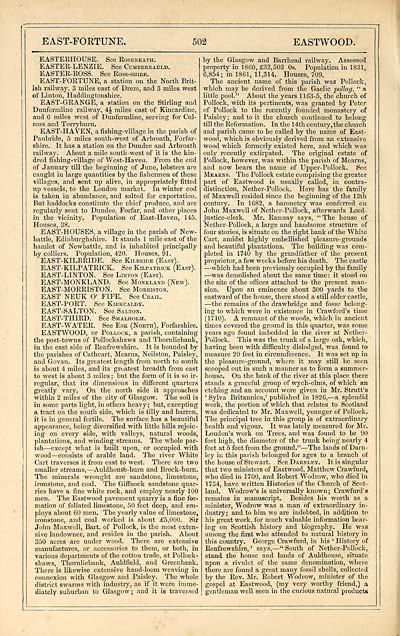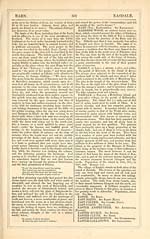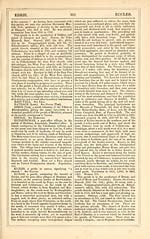Imperial gazeteer of Scotland, or, Dictionary of Scottish topography > Volume 1
(620) Page 502 - EAS
Download files
Complete book:
Individual page:
Thumbnail gallery: Grid view | List view

EAST-FOKTUNE.
502
EASTWOOD.
EASTEKHOUSE. See Roseneath.
EASTER-LENZIE. See Cumbernauld.
EASTEE-EOSS. See Ross-shire.
EAST-FORTUNE, a station on the North Brit-
ish railway, 3 miles east of Drem, and 3 miles west
of Linton, Haddingtonshire.
EAST-GRANGE, a station on the Stirling and
Dunfermline railway, 4J miles east of Kincardine,
and 6 miles west of Dunfermline, serving for Cui-
rass and Torryburn.
EAST-HAVEN, a fishing-village in the parish of
Panhride, 5 miles south-west of Arbroath, Forfar-
shire. It has a station on the Dundee and Arhroath
railway. About a mile south west of it is the kin-
dred fishing-village of West-Haveu. From the end
of January till the beginning of June, lobsters are
caught in large quantities by the fishermen of these
villages, and sent up alive, in appropriately fitted
up vessels, to the London market. In winter cod
is taken in abundance, and salted for exportation.
But haddocks constitute the chief produce, and are
regularly sent to Dundee, Forfar, and other places
in the vicinity. Population of East-Haven, 145.
Houses, 38.
EAST-HOUSES, a village in the parish of New-
battle, Edinburghshire. It stands 1 mile east of the
hamlet of Newbattle, and is inhabited principally
by colliers. Population, 420. Houses, 91.
EAST-KILBRIDE. See Kilbride (East).
EAST-KILPATRICK. See Kilpatrick (East).
EAST-LINTON. See Linton (East).
EAST-MONKLAND. See Monkland (New).
EAST-MORRISTON. See Moeeiston.
EAST NEUK O' FIFE. See Crail.
EAST-PORT. See Kirkcaldy.
EAST-SALTON. See Salton.
EAST-THIRD. See Smalholm.
EAST- WATER. See Esk (North), Forfarshire.
EASTWOOD, or Pollock, a parish, containing
the post-towns of Pollockshaws and Thornliebank,
in the east side of Renfrewshire. It is bounded by
the parishes of Cathcart, Meams, Neilston, Paisley,
and Govan. Its greatest length from north to south
is about 4 miles, and its greatest breadth from east
to west is about 3 miles ; but the form of it is so ir-
regular, that its dimensions in different quarters
greatly vary. On the north side it approaches
within 2 miles of the city of Glasgow. The soil is
in some parts light, in others heavy ; but, excepting
a tract on the south side, which is tilly and barren,
it is in general fertile. The surface has a beautiful
appearance, being diversified with little hills rejoic-
ing on every side, with valleys, natural woods,
plantations, and winding streams. The whole par-
ish — except what is built upon, or occupied with
wood — consists of arable land. The river White
Cart traverses it from east to west. There are two
smaller streams, — Auldhouse-burn and Brock-burn.
The minerals wrought are sandstone, limestone,
ironstone, and coal. The Giffnock sandstone quar-
ries have a fine white rock, and employ nearly 100
men. The Eastwood pavement quarry is a fine for-
mation of foliated limestone, 50 feet deep, and em-
ploys about 60 men. The yearly value of limestone,
ironstone, and coal worked is about £5,000. Sir
John Maxwell, Bart, of Pollock, is the most exten-
sive landowner, and resides in the parish. About
350 acres are under wood. There are extensive
manufactures, or accessories to them, or both, in
various departments of the cotton trade, at Pollock-
shaws, Thornliebank, Auldfield, and Greenbank.
There is likewise extensive hand-loom weaving in
connexion with Glasgow and Paisley. The whole
district swarms with industry, as if it were imme-
diately suburban to Glasgow; and it is traversed
by the Glasgow and Barrhead railway. Assessed
property in 1860, £32,503 0s. Population in 1831,
6,854; in 1861, 11,314. Houses, 709.
The ancient name of this parish was Pollock,
which may be derived from the Gaelic pollag, " a
little pool." About the years 1163-5, the church of
Pollock, with its pertinents, was granted by Peter
of Pollock to the recently founded monastery of
Paisley ; and to it the church continued to belong
till the Reformation. In the 14th century, the church
and parish came to be called by the name of East-
wood, which is obviously derived from an extensive
wood which formerly existed here, and which was
only recently extirpated. The original estate of
Pollock, however, was within the parish of Mearns,
and now bears the name of Upper-Pollock. See
Mearns. The Pollock estate comprising the greater
part of Eastwood is usually called, in contra-
distinction, Nether-Pollock. Here has the family
of Maxwell resided since the beginning of the 1 3tli
century. In 1682, a baronetcy was conferred on
John Maxwell of Nether-Pollock, afterwards Lord-
justice-clerk. Mr. Ramsay says, " The house of
Nether-Pollock, a large and handsome structure of
four stories, is situate on the right bank of the White
Cart, amidst highly embellished pleasure-grounds
and beautiful plantations. The building was com-
pleted in 1740 by the grandfather of the present
proprietor, a few weeks before his death. The castle
— which had been previously occupied by the family
— was demolished about the same time: it stood on
the site of the offices attached to the present man-
sion. Upon an eminence about 300 yards to the
eastward of the house, there stood a still older castle,
— the remains of the drawbridge and fosse belong-
ing to which were in existence in Crawford's time
(1710). A remnant of the woods, which in ancient
times covered the ground in this quarter, was some
years ago found imbedded in the river at Nether-
Pollock. This was the trunk of a large oak, which,
having been with difficulty dislodged, was found to
measure 20 feet in circumference. It was set up in
the pleasure-ground, where it may still be seen
scooped out in such a manner as to form a summer-
house. On the bank of the river at this place there
stands a graceful group of wych-elms, of which an
etching and an account were given in Mr. Strutt's
' Sylva Britannica,' published in 1826, — a splendid
work, the portion of which that relates to Scotland
was dedicated to Mr. Maxwell, younger of Pollock.
The principal tree in this group is of extraordinary
health and vigour. It was lately measured for Mr.
Loudon's work on Trees, and was found to be 90
feet high, the diameter of the trunk being nearly 4
feet at 5 feet from the ground." — The lands of Darn-
ley in this parish belonged for ages to a branch of
the house of Stewart. See Darnlet. It is singular
that two ministers of Eastwood, Matthew Crawfurd,
who died in 1700, and Robert Wodrow, who died in
1734, have written Histories of the Church of Scot-
land. Wodrow's is universally known; Crawfurd's
remains in manuscript. Besides his worth as a
minister, Wodrow was a man of extraordinary in-
dustry; and to him we are indebted, in addition to
his great work, for much valuable information bear-
ing on Scottish history and biography. He was
among the first who attended to natural history in
this country. George Crawfurd, in his ' History of
Renfrewshire, ' says, — " South of Nether-Pollock,
stand the house and lands of Auldhouse, situate
upon a rivulet of the same denomination, where
there are found a great many fossil shells, collected
by the Rev. Mr. Robert Wodrow, minister of the
gospel at Eastwood, (my very worthy friend,) a
gentleman well seen in the curious natural products
502
EASTWOOD.
EASTEKHOUSE. See Roseneath.
EASTER-LENZIE. See Cumbernauld.
EASTEE-EOSS. See Ross-shire.
EAST-FORTUNE, a station on the North Brit-
ish railway, 3 miles east of Drem, and 3 miles west
of Linton, Haddingtonshire.
EAST-GRANGE, a station on the Stirling and
Dunfermline railway, 4J miles east of Kincardine,
and 6 miles west of Dunfermline, serving for Cui-
rass and Torryburn.
EAST-HAVEN, a fishing-village in the parish of
Panhride, 5 miles south-west of Arbroath, Forfar-
shire. It has a station on the Dundee and Arhroath
railway. About a mile south west of it is the kin-
dred fishing-village of West-Haveu. From the end
of January till the beginning of June, lobsters are
caught in large quantities by the fishermen of these
villages, and sent up alive, in appropriately fitted
up vessels, to the London market. In winter cod
is taken in abundance, and salted for exportation.
But haddocks constitute the chief produce, and are
regularly sent to Dundee, Forfar, and other places
in the vicinity. Population of East-Haven, 145.
Houses, 38.
EAST-HOUSES, a village in the parish of New-
battle, Edinburghshire. It stands 1 mile east of the
hamlet of Newbattle, and is inhabited principally
by colliers. Population, 420. Houses, 91.
EAST-KILBRIDE. See Kilbride (East).
EAST-KILPATRICK. See Kilpatrick (East).
EAST-LINTON. See Linton (East).
EAST-MONKLAND. See Monkland (New).
EAST-MORRISTON. See Moeeiston.
EAST NEUK O' FIFE. See Crail.
EAST-PORT. See Kirkcaldy.
EAST-SALTON. See Salton.
EAST-THIRD. See Smalholm.
EAST- WATER. See Esk (North), Forfarshire.
EASTWOOD, or Pollock, a parish, containing
the post-towns of Pollockshaws and Thornliebank,
in the east side of Renfrewshire. It is bounded by
the parishes of Cathcart, Meams, Neilston, Paisley,
and Govan. Its greatest length from north to south
is about 4 miles, and its greatest breadth from east
to west is about 3 miles ; but the form of it is so ir-
regular, that its dimensions in different quarters
greatly vary. On the north side it approaches
within 2 miles of the city of Glasgow. The soil is
in some parts light, in others heavy ; but, excepting
a tract on the south side, which is tilly and barren,
it is in general fertile. The surface has a beautiful
appearance, being diversified with little hills rejoic-
ing on every side, with valleys, natural woods,
plantations, and winding streams. The whole par-
ish — except what is built upon, or occupied with
wood — consists of arable land. The river White
Cart traverses it from east to west. There are two
smaller streams, — Auldhouse-burn and Brock-burn.
The minerals wrought are sandstone, limestone,
ironstone, and coal. The Giffnock sandstone quar-
ries have a fine white rock, and employ nearly 100
men. The Eastwood pavement quarry is a fine for-
mation of foliated limestone, 50 feet deep, and em-
ploys about 60 men. The yearly value of limestone,
ironstone, and coal worked is about £5,000. Sir
John Maxwell, Bart, of Pollock, is the most exten-
sive landowner, and resides in the parish. About
350 acres are under wood. There are extensive
manufactures, or accessories to them, or both, in
various departments of the cotton trade, at Pollock-
shaws, Thornliebank, Auldfield, and Greenbank.
There is likewise extensive hand-loom weaving in
connexion with Glasgow and Paisley. The whole
district swarms with industry, as if it were imme-
diately suburban to Glasgow; and it is traversed
by the Glasgow and Barrhead railway. Assessed
property in 1860, £32,503 0s. Population in 1831,
6,854; in 1861, 11,314. Houses, 709.
The ancient name of this parish was Pollock,
which may be derived from the Gaelic pollag, " a
little pool." About the years 1163-5, the church of
Pollock, with its pertinents, was granted by Peter
of Pollock to the recently founded monastery of
Paisley ; and to it the church continued to belong
till the Reformation. In the 14th century, the church
and parish came to be called by the name of East-
wood, which is obviously derived from an extensive
wood which formerly existed here, and which was
only recently extirpated. The original estate of
Pollock, however, was within the parish of Mearns,
and now bears the name of Upper-Pollock. See
Mearns. The Pollock estate comprising the greater
part of Eastwood is usually called, in contra-
distinction, Nether-Pollock. Here has the family
of Maxwell resided since the beginning of the 1 3tli
century. In 1682, a baronetcy was conferred on
John Maxwell of Nether-Pollock, afterwards Lord-
justice-clerk. Mr. Ramsay says, " The house of
Nether-Pollock, a large and handsome structure of
four stories, is situate on the right bank of the White
Cart, amidst highly embellished pleasure-grounds
and beautiful plantations. The building was com-
pleted in 1740 by the grandfather of the present
proprietor, a few weeks before his death. The castle
— which had been previously occupied by the family
— was demolished about the same time: it stood on
the site of the offices attached to the present man-
sion. Upon an eminence about 300 yards to the
eastward of the house, there stood a still older castle,
— the remains of the drawbridge and fosse belong-
ing to which were in existence in Crawford's time
(1710). A remnant of the woods, which in ancient
times covered the ground in this quarter, was some
years ago found imbedded in the river at Nether-
Pollock. This was the trunk of a large oak, which,
having been with difficulty dislodged, was found to
measure 20 feet in circumference. It was set up in
the pleasure-ground, where it may still be seen
scooped out in such a manner as to form a summer-
house. On the bank of the river at this place there
stands a graceful group of wych-elms, of which an
etching and an account were given in Mr. Strutt's
' Sylva Britannica,' published in 1826, — a splendid
work, the portion of which that relates to Scotland
was dedicated to Mr. Maxwell, younger of Pollock.
The principal tree in this group is of extraordinary
health and vigour. It was lately measured for Mr.
Loudon's work on Trees, and was found to be 90
feet high, the diameter of the trunk being nearly 4
feet at 5 feet from the ground." — The lands of Darn-
ley in this parish belonged for ages to a branch of
the house of Stewart. See Darnlet. It is singular
that two ministers of Eastwood, Matthew Crawfurd,
who died in 1700, and Robert Wodrow, who died in
1734, have written Histories of the Church of Scot-
land. Wodrow's is universally known; Crawfurd's
remains in manuscript. Besides his worth as a
minister, Wodrow was a man of extraordinary in-
dustry; and to him we are indebted, in addition to
his great work, for much valuable information bear-
ing on Scottish history and biography. He was
among the first who attended to natural history in
this country. George Crawfurd, in his ' History of
Renfrewshire, ' says, — " South of Nether-Pollock,
stand the house and lands of Auldhouse, situate
upon a rivulet of the same denomination, where
there are found a great many fossil shells, collected
by the Rev. Mr. Robert Wodrow, minister of the
gospel at Eastwood, (my very worthy friend,) a
gentleman well seen in the curious natural products
Set display mode to: Large image | Transcription
Images and transcriptions on this page, including medium image downloads, may be used under the Creative Commons Attribution 4.0 International Licence unless otherwise stated. ![]()
| Gazetteers of Scotland, 1803-1901 > Imperial gazeteer of Scotland, or, Dictionary of Scottish topography > Volume 1 > (620) Page 502 - EAS |
|---|
| Permanent URL | https://digital.nls.uk/97466570 |
|---|
| Description | Volume I: Aan-Gordon. |
|---|---|
| Attribution and copyright: |
|

